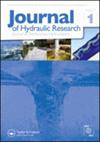Analytical and experimental study of velocity distribution in adverse-slope channel flow
IF 1.7
3区 工程技术
Q3 ENGINEERING, CIVIL
引用次数: 0
Abstract
The prediction of the velocity distribution in adverse-slope flow is improved by analytical and experimental study of the wake and dip effects, based on the log-wake-dip velocity law. This improved equation allows accurate prediction of the wake phenomenon and dip phenomenon. The equation compares very well with the experimental data obtained in the present study and some reference data, and it predicts better than other formulations available in the literature. This study shows that the wake-parameter can be expressed by the linear equation for the pressure-gradient parameter, under the conditions of the respective Reynolds number and aspect ratio. The dip-parameter can be determined as constants using the known position of the maximum velocity point. When the pressure gradient is relatively small, the wake effect is a boost to velocity. In contrast, when the pressure gradient is relatively large, the wake effect is an impediment to velocity.反坡渠道水流速度分布的分析与实验研究
在对数尾迹-倾角速度规律的基础上,通过尾迹和倾角效应的分析和实验研究,改进了逆坡流中速度分布的预测。改进后的方程可以准确地预测尾迹现象和倾斜现象。该方程与本研究的实验数据和一些参考数据比较良好,预测效果优于文献中的其他公式。研究表明,在雷诺数和展弦比相同的条件下,尾迹参数可以用压力梯度参数的线性方程来表示。倾角参数可以用已知的最大速度点位置确定为常数。当压力梯度较小时,尾迹效应对速度有促进作用。相反,当压力梯度较大时,尾迹效应对速度有阻碍作用。
本文章由计算机程序翻译,如有差异,请以英文原文为准。
求助全文
约1分钟内获得全文
求助全文
来源期刊

Journal of Hydraulic Research
工程技术-工程:土木
CiteScore
4.90
自引率
4.30%
发文量
55
审稿时长
6.6 months
期刊介绍:
The Journal of Hydraulic Research (JHR) is the flagship journal of the International Association for Hydro-Environment Engineering and Research (IAHR). It publishes research papers in theoretical, experimental and computational hydraulics and fluid mechanics, particularly relating to rivers, lakes, estuaries, coasts, constructed waterways, and some internal flows such as pipe flows. To reflect current tendencies in water research, outcomes of interdisciplinary hydro-environment studies with a strong fluid mechanical component are especially invited. Although the preference is given to the fundamental issues, the papers focusing on important unconventional or emerging applications of broad interest are also welcome.
 求助内容:
求助内容: 应助结果提醒方式:
应助结果提醒方式:


